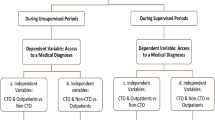Abstract
Outpatient commitment is examined in order to determine what types of civil commitment respondents are ordered to outpatient treatment. The sample consisted of 1226 adult civil commitment respondents having initial hearings in North Carolina. Respondents placed on outpatient commitment are compared with respondents who were released and respondents who were committed to the hospital. Respondents ordered to outpatient commitment are significantly more likely to be of the chronic, revolving door population of mental patients. Potential problems in evaluating the success of outpatient commitment are discussed.
Similar content being viewed by others
References
Chambers, D. (1978). Community-based treatment and the constitution. In L. Stern & M. A. Test (Eds.).Alternatives to mental hospital treatment (pp. 23–39). New York: Plenum Books.
Gronfein, W. (1985, Sept.). Incentives and intentions in mental health policy: A comparison of the Medicaid and Community Mental Health Programs.Journal of Health and Social Behavior, 26, 192–206.
Gunn, L. (1986). Origin and implementation of North Carolina's outpatient commitment law. (Processed).
Hiday, V. A., & Goodman R. R. (1982. Spring). The least restrictive alternative to involuntary hospitalization, outpatient commitment: Its use and effectiveness.The Journal of Psychiatry and Law, 81–96.
Kaplan, H. & Bohr, R. H. (1976). Change in the mental health field?Community Mental Health Journal, 12(3) 244–251.
Keilitz, I. & Hall, T. (1985). State statutes governing involuntary outpatient civil commitment.MPDLR, 9(5), 103–107.
Kirk, S. A. & Therrien, M. E. (1975). Community mental health myths and the fates of former hospitalized patients.Psychiatry, 38, 209–217.
Miller, R. D. (1985). Commitment to outpatient treatment: a national survey.Hospital and Community Psychiatry, 36(3), 265–267.
Morrissey, J. P. (1982). Deinstitutionalizing the mentally ill. In W. Gove (Ed.).Deviance and mental illness. Vol. 6. (pp. 147–178), Beverly Hills, CA: Sage Publications.
Morrissey, J. P. Goldman, H. H., & Klerman, L. V. (1980).The enduring asylum. New York: Grune & Stratton.
O'Meara, M. J. (1984). Involuntary civil commitment expanded: The 1983 changes.North Carolina Law Review, 62(6):1158–1166.
Owens, J. (1985) Involuntary outpatient commitment: An exploration of the issues and its utilization in five states. (Number 85m046982501d). Prepared for the Division of Educational Services System Laison of the NIMH.
Stern, R. & Minkoff, K. (1979). Paradoxes in programming for chronic patients in a community clinic.Hospital and Community Psychiatry, 30(9), 613–617.
Wilson, H. S. (1982).Deinstitutionalized residential care for the mentally disordered. New York: Grune & Strath.
Author information
Authors and Affiliations
Rights and permissions
About this article
Cite this article
Scheid-Cook, T.L. Commitment of the mentally ill to outpatient treatment. Community Ment Health J 23, 173–182 (1987). https://doi.org/10.1007/BF00754429
Issue Date:
DOI: https://doi.org/10.1007/BF00754429




